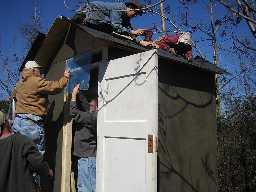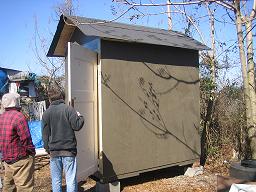Mad Housers Build Huts for the Homeless
 (APN) ATLANTA — The Mad Housers, a non-profit, volunteer, charitable organization founded in 1988 by a group of Georgia Tech architecture students, builds emergency huts for the homeless in the Atlanta area at no charge.
(APN) ATLANTA — The Mad Housers, a non-profit, volunteer, charitable organization founded in 1988 by a group of Georgia Tech architecture students, builds emergency huts for the homeless in the Atlanta area at no charge.
“We are just providing a basic piece of capital,” Nick Hess, 35, President of The Mad Housers, told Atlanta Progressive News (APN). The organization sees the huts as a tool to help the homeless survive and do not view what they do as “giving handouts.”
“This is not supposed to be where they live the rest of their lives,” Chad Jubyna, 36, a Mad Housers volunteer, said. “[These huts are] supposed to be a stepping stone so [the client] can have a safe place to put their things, a more secure place to sleep and stay warm.”
Each year, The Mad Housers seeks to build 18 huts and actually construct about 16. Most huts are 6 feet by 8 feet, are 10 feet tall, and are big enough for one person. They are simple structures, comprised of four walls with a gabled roof, a sleeping loft, a locking door and a stove for heating and cooking.
Atlanta Progressive News was fortunate enough to observe and participate in one of these builds on Sunday, February 26, 2006. To protect the privacy and safety of Mad Housers’ clients, APN has agreed not disclose the location of this hut nor any of the others.
Once on the brink of dissolution, the Mad Housers are stronger and better than ever.
“We’re doing a lot better,” Hess told Atlanta Progressive News (APN). “We have a warehouse, mailbox, an office, officers, and a functioning board.” Just five years ago, the Mad Housers did not have any of these.
Hess first became involved with the group in 1991 as a Computer Science student at Georgia Tech. After several years, Hess left the organization because of conflict and infighting. He returned in 2000, became President, and began working hard with other members to bring the Mad Housers back from the brink.
“I am fully confident that if I were to drop dead right now, the organization would be fine without me,” said Hess.
Volunteer rolls have swelled to over 150 in five years and show no signs of slowing down. “The volunteers we have are the greatest people on Earth,” Hess told APN. “These are guys who take responsibility, who stick with it, even when the rewards are nebulous, and who understand what we’re doing and why.”
“I’ve always wanted to do something with the homeless [and working with the Mad Housers] seemed like the perfect opportunity,” said Chad Jubnya, 36, a Mad Housers volunteer for three years who has participated in nearly 20 builds.“I’d like to be able to help more people,” Jubnya told APN. “I wish we could build every week but it’s a lot for the volunteers.”
The Mad Housers receives monetary donations from individuals and, because Mad Housers is a nonprofit organization, people who donate money can write off their donation come tax time. Mad Housers also takes old paint, doors, cinder blocks, firewood, and 2 x 4’s from anyone who wants to give.
“We’ve built up a fairly decent surplus [of donations],” Hess told APN. For example, the group can call Home Depot, order $1500 worth of materials, and have it delivered for $50. This is a luxury the Mad Housers could not afford five years ago.
So whom do the Mad Housers help? “We handle from the absolute no-hopers to folks who are struggling,” said Hess.
One client for whom The Mad Housers built a hut worked at McDonald’s for 10 years. Because he could only work 28 hours per week at minimum wage, he could not receive benefits. This client struggled for years, going in and out of his hut, before he finally earned the means to leave the hut for good. Other clients are so destitute that it is doubtful they will ever leave their huts.
The screening process is not too rigorous. However, “it’s difficult…to find people who can survive out there,” Jubnya told APN.
“We can only get to a certain type of person,” said Jubnya. “You can’t just take somebody from downtown and bring them out to the woods,” Jubyna told APN, referring to certain homeless people’s ability to survive in the wilderness.
The Mad Housers do not run the camps where they build huts. But Hess told APN the organization would not hesitate to take action if they feel trouble is brewing.
“We will shelter people who have addiction issues even though there’s the possibility of trouble,” said Hess. “It’s the likelihood of trouble that we’re worried about.”
“We don’t want camps to become crack dens. When somebody becomes a hazard, we will and we have come in with crowbars and taken [a hut] down,” said Hess.
“If we get the impression from you that you’re engaged in activities that’s going to bring negative attention to you,” then The Mad Housers will not build a hut for that person.
While volunteers do return to visit camps to weatherproof huts based on the season and make needed repairs, the Mad Housers generally take a hands off approach to the camps, choosing to let the residents manage their own affairs.
Receiving permission to build a hut on a site can be a complex issue. The Mad Housers do not generally ask permission to build on a site. Instead of creating camps, the Mad Housers find existing camps and build huts in hopes of improving the camps. If a camp has been at a site for a long time, then either: the owner is aware of the presence and is OK with it, the owner does not know the camp exists, or the ownership of the land is in dispute and homeless people are living there until the dispute is settled, which could take years, according to The Mad Housers website.
The Mad Housers leaves it up to the homeless individuals seeking assistance to make arrangements for permission with owners of the abandoned properties where the huts are to be built, where applicable, Atlanta Progressive News has learned.
Whenever an owner asks for a hut to be taken down, the Mad Housers always comply. The police do not cause trouble for the camps as long as the residents do not cause trouble.
Volunteers, who become volunteers by simply showing up to the warehouse on building day, load a truck with all the necessary materials and depart in as few vehicles as possible. We arrived at the site at around 11 a.m. and finished construction around 2:15 p.m.
The entire process, from fashioning raw materials into appropriate components to completing a hut takes approximately 50 man-hours at a cost of around $450. Once completed, the ownership of a hut goes to the client and that person makes improvements as he or she sees fit.
If a client is able to move out of a hut, then another person can come in and live there. Some huts have lasted well over five years, when they were meant to last only two. “It’s not an end solution,” said Jubyna. “It’s supposed to be part of a process of helping.”
The organization is developing two other types of huts to meet the needs of clients, according to madhousers.org. One design calls for more space to accommodate a client who is married or in a long-term relationship. These huts are built with a higher roof pitch and a loft with more headroom.
The other design is a low rider, a four foot cubed structure that is for sitting and sleeping only and less visible. Because of the compact dimensions, these do not have stoves because of the fire hazard. A small front porch provides sitting space, making the low rider feel less like a bunker.
A Mad Housers hut has been on display at the Athica Gallery in Athens, Georgia, since late January of this year. The hut contains many photos of other Mad Housers huts and literature about the organization. Sunday March 5th, 2006, will be the last day to see this hut before the exhibit closes. The Mad Housers intend to find a client in Athens who can live in the displayed hut.
